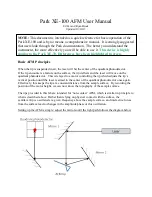
8
Useful microscopy definitions and Research Scope
options
Objective Lenses
There are typically three types of objective lenses found on brightfield
microscopes -
Achromat, semi-plan, and plan objectives
. To
understand the difference, realize that all microscope lenses are curved, which
results in an image that is slightly out of focus at the edges, and may produce
chromatic or spherical aberrations due to this curved shape.
Achromat Objective
- An
achromatic lens
(
achromat
) is an objective
lens that is designed to limit the effects of
chromatic
and
spherical
aberration
(See notes below). Achromatic lenses are corrected by bringing
two wavelengths (typically red and blue) into focus in the same plane. An
objective that is Achromatic carries the implication (guarantee) that at least
60% of the field of view will have a quality flat focus.
Semi-Plan Objective
-
Semi-Plan
objectives are guaranteed to have a
quality flat field of focus for 80% of the field of view. A
Semi-Plan
Achromat
lens is also corrected for chromatic aberrations, as described
above.
Plan Objective
- Plan Objectives guarantee a quality flat field of focus for
100% of the field of view. A
Plan Achromat
lens will also have the same
corrections for chromatic aberrations as noted above. In Plan Objectives
when imaging the field, parts of the specimen at the edge of the visual field
are almost as well focused
as those in the center. Straight lines on the
specimen appear straight throughout the visual field, without any aberrations.
Such microscopes are especially good for photomicrography. In general, the
better the plan field objective, the more expensive the lens.
Flat Field Objectives
- As one looks at the field of view, there may be slight
blurring at the edge of the field. This edge blurring of
Flat Field
objectives is
slight and easily corrected by a small tweak of the fine focus knob as one looks
toward the edge of the field, or by moving the specimen so that the portion
that is at the edge is moved into the center of the viewing field. Flat Field
Objectives tend to be inexpensive when compared to Plan Field.
Plan Field versus Flat Field Objectives
- Most educational, teaching
microscopes are Flat Field Objectives due to this cost difference.
Infinity - Infinity lenses
- In microscopy, the term "infinity" means that the
objective lenses are designed to project their images to infinity, not to some
finite distance. Traditional brightlight microscopes had a "fixed" focal point at
Содержание Research Scope T-29031
Страница 2: ...2 ...






























